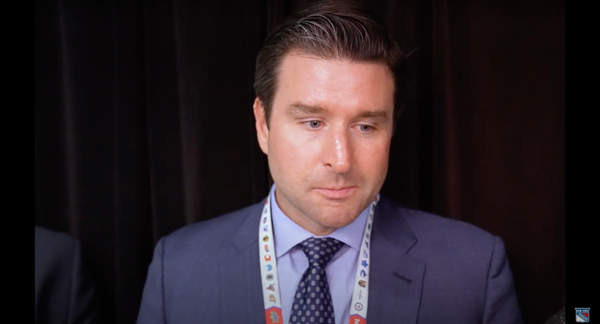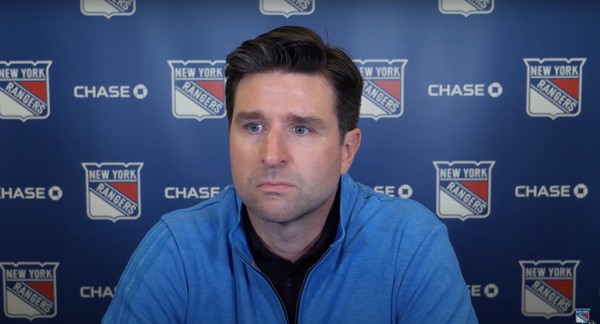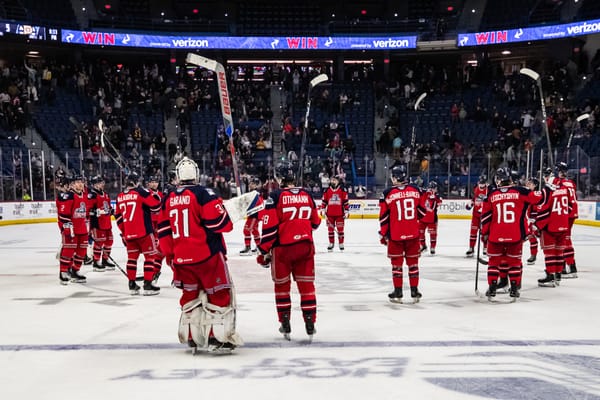Once Upon A Time in RangersTown: Guy Lafleur
The third entry in a series looking at Rangers who spent a year or less in New York
Welcome to the third edition of “Once Upon A Time in Rangerstown.” Today we are going to be looking at a Hall of Fame skater whose resume includes five Stanley Cups, three Lester B. Pearson Trophies, three Art Ross Trophies, two Hart Trophies, and a Conn Smythe Trophy. That player is Guy “Le Démon Blond” Lafleur, and his tenure with the Rangers came at a time just before the Blueshirts started making major changes which would put them on a path to becoming a Stanley Cup champion again.
The Player: Guy Lafleur | Age 37 | Right Wing
Guy Lafleur was one helluva player, and a key contributor to the Montreal Canadiens dynasty which captured six Stanley Cups — including four in a row — during the 1970s.
Lafleur was selected No. 1 overall in the 1971 draft, and had a solid rookie season in which he tallied 64 points in 73 games. You may be asking how the Canadiens — who won the Stanley Cup during the 1970-71 season — selected Lafleur, and for that answer you can go over to SB Nation’s Habs Eyes on the Prize for the full story.
Related
Sam Pollock: A Beautiful Mind Part II - How the Habs got Guy Lafleur
Lafleur’s sophomore season saw a bit of a dip — 55 points in 69 games — but he added eight points in 17 playoff games to help Montreal win the Stanley Cup during the 1972-73 season. Once he acclimated to the league and became a top line player for Montreal, Lafleur was one of the NHL’s leading players, and a true force.
Between the 1974-75 and 1979-1980 season Lafleur averaged at least 50 goals and 100 points, and became the first NHL player to achieve the feat six years in a row. During this time period he posted a staggering league-leading line of 327-439-766 in just 462 games which averages out to 1.65 points per game. For those interested, Marcel Dionne — the No. 2 overall pick of the 1971 draft — was second during the period with a line of 288-395-683 in 470 games played. Lafleur also shined in the postseason during this six year period with 51 goals and 110 points in 72 games.
After winning his last Stanley Cup with the Habs in 1979, Lafleur’s game started to dip from the level he’d be playing it at due to injuries, and he was limited to 70 points in 51 games during the 1980-81 campaign. It was at this time he was in a major car accident which saw him hit a signpost after falling asleep at the wheel of his rental car which resulted in Lafleur losing part of his right earlobe.
That year he scored just 27 goals, and it was the first time since 1973-74 in which he failed to score 50 or more goals. The next three seasons saw him finish with 84, 76, and 70 points respectively, which were fine all things considered, but it was evident that he wasn’t the same player he’d been.
Lafleur eventually retired during the 1984-85 season after playing just 19 games. Clashes with head coach Jacques Lemaire about not playing defense and an unwillingness by general manager Serge Savard to honor Lafleur’s trade request were just some of the factors which led to his early and unexpected retirement. Lafleur would later be inducted into the Hockey Hall of Fame in 1988, but as we now know, he still had the fire to play.
The Deal: August 19, 1988 | Signs One-Year Deal Contingent on Performance in Training Camp
The dynamic scoring winger wanted to make an NHL comeback after taking a few years off, and he originally wanted to sign with the Los Angeles Kings, where he likely would have played with Wayne Gretzky, but a deal never came to fruition. Rangers general manager Phil Esposito then gave him a one-year deal that was contingent on how he looked in training camp, and he ultimately got the job after out performing veterans and prospects alike.
The Why: Lafleur Earned the Job In Training Camp
Lafleur’s contract was signed with the understanding he had to do well in training camp, and he played his way into a deal which included a team option and 15 percent raise for the 1989-90 season. Michel Bergeron was the Rangers head coach at the time, and he was impressed with how well the Hall of Famer played despite taking a few years off.
We all agreed that Guy was one of our best players at training camp, said Bergeron, who declined to estimate the goal-scoring impact Lafleur could have. ‘We all remember Guy Lafleur as a 50-goal scorer. I don’t honestly think he’s going to score 50 goals for us, but I said before camp that if he was one of the best 24 players he was going to make the team, and he made it.
Lafleur felt good about his game too, and said, “this is only the second time in my life as a professional where I had to go to camp and make a team. I really believed I could make it, without really knowing it. I think I deserved it.”
Esposito was skeptical at first about what Lafleur would be able to offer the Rangers, but eventually came around to see that he potentially could help the team make the playoffs in a supporting role.
After watching him closely, he may consistently have been our best forward,He brings a winning attitude to this club. When you’ve got a talent like Mr. Lafleur has, well, maybe it’s not as great as it was at 21, but maybe it is. We’ll just have to wait and see.
The 1987-88 Rangers had finished with a record of 36-34-10 and 82 points, and failed to make the playoffs. In the offseason Phil Esposito made upgrading the defense a priority, and he traded leading scorer Walt Poddubny to the Quebec Nordiques along with Bruce Bell, Jari Gronstrand, and a 1989 fourth-round pick for Jason Lafreniere and Normand Rochefort,
The reason I bring this up is that the trade was made on August 1, 1988, and Lafleur was signed nearly three weeks later. It’s quite possible that Lafleur was looked at as someone who could help make up some of the offense lost in the Poddubny trade, but we may never know unless someone is able to talk to Phil Esposito,
The Season: 37-35-8, 82 points | 3rd place in Patrick Division
The 1988-89 Rangers ended up having an average season in which they finished third in the Patrick Division, but a pair of five game losing streaks at the end of the season cost them the division title.
On March 2, 1989, the Rangers held a record of 34-23-8 with 76 points, and sat first in the division and second place in the Wales Conference. They then went on a five game losing streak, and 10 days later found themselves third in the division and fourth in the conference. The team bounced back with a victory over Calgary, lost vs. Winnipeg and Quebec, and then won a pair vs. St. Louis and the Minnesota North Stars. At this point there were five games left in the season, and the Blueshirts sat second in the division and third in the conference.
The Rangers lost the last five games in a row, and ended the year third in the division and sixth in the conference before getting swept by the Pittsburgh Penguins in the Patrick Division Semifinals.
From a statistical perspective, the teams leading contributors were Tomas Sandstrom (32-56-88), Brian Leetch (23-48-71 in 68 GP), Brian Mullen (29-35-64), Tony Granato (36-27-63), and Kelly Kisio (26-36-62). John Vanbiesbrouck started 56 games in goal and posted a record of 28-21-4 with a 3.69 GAA and a .881 SV%
This team also featured a number of players who would go on to becomes coaches or join front offices, and the list includes names such as Lindy Ruff, Peter Laviolette, Brian Lawton, Don Maloney, and the aforementioned Tony Granato among others.
The Play: 67 games | 18-27-45
Lafleur played pretty decent hockey for a 37-year-old winger who’d been out of the game for a few years, and got off to a good start with the Rangers.
Guy Lafleur's first goal as a New York Ranger. pic.twitter.com/lLWWgN6jWH
— Tom Urtz Jr. (@TomUrtzJr) May 5, 2020
In his first month as a Blueshirt, Lafleur tallied eight points in 11 games. November was a better month, and he ended the month with 10 points in 13 games. Things were looking good in December as Lafleur tallied five points in his first four games, but was sidelined a month after suffering a minor bone fracture in his foot.
It took a bit for Lafleur to get up to speed upon return, and January saw him tally six points in 11 games. By February he was readjusted and back to being a top contributor in which he scored seven goals and tallied 11 points in 12 games. From this point on, however, Lafleur looked like a 37-year-old who was struggling to keep up. He’d appear in 16 games in March and April for the Blueshirts, and tallied just a goal and four assists for five points. He played in all four of the Rangers’ playoff games vs. the Penguins, and picked up his lone point by scoring a goal in Game 2 of the series.
The End: Rangers Trade Lafleur’s Rights to Quebec
With two games left in the regular season, Esposito fired head coach Michel Bergeron and went behind the bench for the team’s playoff series vs. Pittsburgh. A few weeks later Esposito himself was also without a job. During this tumultuous time there appeared to be little negotiation to keep Lafleur around, and the Rangers ended up transferring his rights to the Quebec Nordiques for $100,000 and a future draft pick.
That future draft pick was then used to select Sergei Zubov, which worked out pretty good for the Rangers... until they traded him to Pittsburgh.
Lafleur could have made more money by signing with the Kings — the team he originally wanted to join when starting his NHL comeback — but wanted to return to Quebec where he started his hockey career and once again play for his good friend Michel Bergeron.
All in all, Lafleur’s tenure with the Rangers was average all things considered. He played solid hockey for a 37 year old, and likely would have challenged 60 points had he not broken his foot. He also brought a solid veteran presence to a pretty young team who had pieces that would ultimately go on to play bigger roles in the league years down the line.
There was reason to be skeptical about the signing at the beginning, but after a strong camp he showed he belonged and produced well enough for himself, even finishing eighth in team scoring. The Rangers, however, did make the right decision to move on from Lafleur, as he tallied 34 points in 39 games in year one, and 28 points in 59 games in year two with the Nordiques.
Stats via Hockey-Reference unless otherwise noted, and NHL standings data via SHRP Sports





